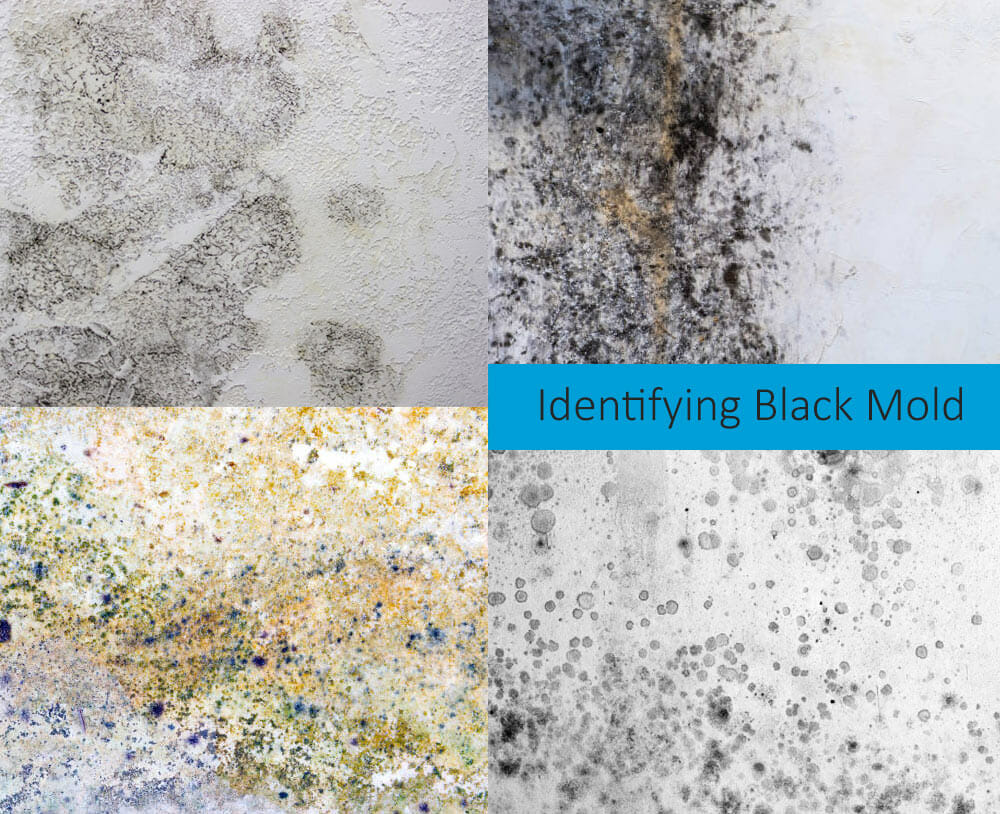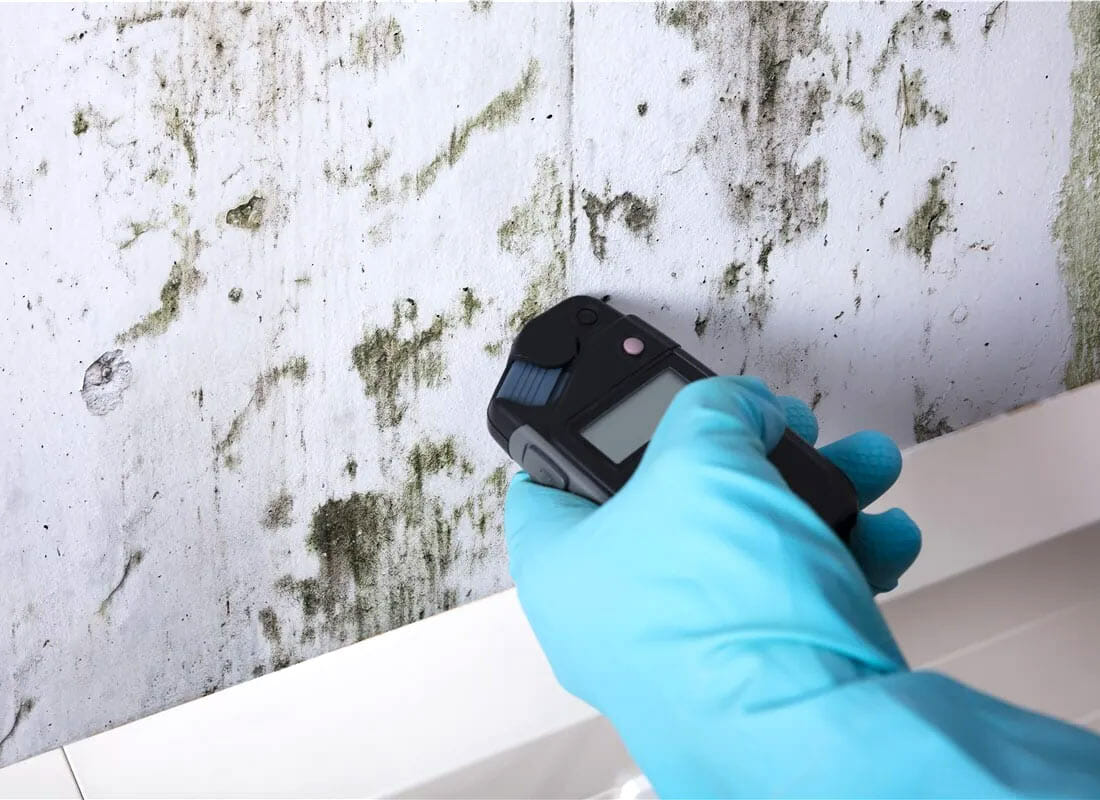Recognizing black mold isn’t necessarily easy since it can appear in different shades and consistencies. However, when black mold matures, it typically becomes black and might look like a slimy layer accumulating on organic materials. It might also produce a musty odor, signaling its existence.
It is crucial to note that not all black molds are toxic, and not all toxic molds are black. Therefore, it is essential to have a professional inspection to determine the type of mold and the best course of action for removal.

What we cover
ToggleIdentifying Black Mold
Black mold is a type of fungus that can grow in damp and humid environments. It can be harmful to human health, so it’s important to identify it and take appropriate measures to remove it. Here are some ways to identify black mold.
Color and Texture
Black mold is usually black or dark green. However, it can also appear grayish or brownish. It has a slimy or fuzzy texture and can grow in patches or clusters. Black mold can also have a musty or earthy smell.
Mold Vs Mildew
Mold and mildew are both types of fungi, but they have some differences. Mildew is usually white or gray and has a powdery or fluffy texture. It grows on surfaces that are damp or moist, such as shower walls or windowsills. Mold, on the other hand, can be black, green, or other colors and has a slimy or fuzzy texture. It can grow on a variety of surfaces, including wood, drywall, and carpet.
Common Locations
Black mold can grow in a variety of locations, but it tends to thrive in damp and humid environments. Some common places where black mold can be found include:
- Bathrooms: Black mold can grow on shower walls, under sinks, and around toilets.
- Basements: Basements can be damp and humid, making them a prime location for black mold growth.
- Attics: Attics can be humid and poorly ventilated, which can lead to black mold growth on insulation or other surfaces.
- Kitchens: Black mold can grow on kitchen surfaces that are regularly exposed to moisture, such as around the sink or refrigerator.
If you suspect that you have black mold in your home, it’s important to take action to remove it. You can hire a professional mold remediation company to handle the job, or you can try to remove the mold yourself using appropriate safety measures and cleaning products.
Health Risks of Black Mold
Exposure to black mold can cause various health problems, especially in people with weakened immune systems, allergies, or respiratory conditions. Here are some of the health risks associated with black mold exposure:
- Allergic reactions: Black mold can trigger allergic reactions in some people, causing symptoms such as sneezing, runny nose, itchy eyes, skin rashes, and hives. These symptoms can be mild or severe, depending on the individual’s sensitivity to the mold.
- Respiratory problems: Black mold can also cause or worsen respiratory problems, such as asthma, bronchitis, and pneumonia. Inhaling black mold spores can irritate the lungs and airways, leading to coughing, wheezing, shortness of breath, and chest tightness.
- Neurological symptoms: Some studies suggest that exposure to black mold may cause neurological symptoms, such as headaches, dizziness, memory loss, and mood changes. However, more research is needed to confirm these findings.
- Infections: In rare cases, black mold can cause infections in people with weakened immune systems, such as those with HIV/AIDS, cancer, or organ transplants. These infections can be life-threatening and require immediate medical attention.
To minimize the health risks of black mold exposure, it’s important to take preventive measures, such as:
- Keep your home dry: Black mold thrives in damp and humid environments, so it’s essential to keep your home dry and well-ventilated. Use dehumidifiers, air conditioners, and exhaust fans to reduce moisture levels in the air.
- Fix leaks and water damage: If you notice any leaks or water damage in your home, fix them immediately to prevent mold growth. Clean and dry any wet materials within 24-48 hours to prevent mold from growing.
- Clean mold promptly: If you spot any black mold in your home, clean it promptly and thoroughly using a solution of bleach and water or a commercial mold cleaner. Wear protective gear, such as gloves and a mask, to avoid inhaling mold spores.
If you experience any symptoms of black mold exposure, such as respiratory problems or allergic reactions, seek medical attention promptly. A healthcare professional can diagnose and treat the underlying cause of your symptoms and recommend appropriate treatment options.
Preventing Black Mold Growth
Black mold is a type of fungus that can grow in damp and humid environments. It can cause health problems, especially for people who have allergies or respiratory issues. Preventing black mold growth is essential for maintaining a healthy living environment.
Proper Ventilation
Proper ventilation is crucial in preventing black mold growth. Good ventilation helps to reduce humidity levels and prevent moisture buildup. Here are some tips for improving ventilation:
- Open windows and doors to allow air to circulate.
- Use exhaust fans in the bathroom and kitchen to remove excess moisture.
- Install a dehumidifier to control humidity levels in the home.
Moisture Control
Moisture control is another critical factor in preventing black mold growth. Here are some tips for controlling moisture:
- Fix any leaks in pipes, roofs, or windows immediately.
- Clean up any spills or water damage promptly.
- Use a moisture meter to check for moisture levels in walls, floors, and ceilings.
- Use waterproof materials in areas that are prone to moisture, such as bathrooms and kitchens.
By following these tips, you can prevent black mold growth in your home and maintain a healthy living environment. It is essential to address any mold growth immediately to prevent it from spreading and causing health problems.
Professional Mold Inspection
If you suspect that your home may have black mold, it is essential to call a professional mold inspector. Professional mold inspectors have the experience and equipment necessary to identify the presence of mold, determine its type, and assess the extent of the mold growth.
During a professional mold inspection, the inspector will conduct a visual inspection of your home, looking for signs of mold growth. They may also use specialized equipment such as moisture meters and thermal imaging cameras to detect hidden mold growth behind walls and other surfaces.
If the inspector does find mold growth, they will take samples of the mold for laboratory analysis. The laboratory analysis will identify the type of mold present and determine the concentration of mold spores in the air.

Report results
Based on the results of the inspection and laboratory analysis, the mold inspector will provide you with a detailed report outlining the extent of the mold growth, the type of mold present, and recommendations for mold remediation.
It is important to note that not all mold inspectors are created equal. When choosing a mold inspector, make sure to choose a reputable company with experienced and certified mold inspectors. Look for companies that have a proven track record of providing high-quality mold inspection services and have positive reviews from previous customers.
Removal and Remediation of Black Mold
Removing black mold is important to prevent health problems and structural damage to your property. It is recommended to hire a professional mold remediation company to handle the removal process.
The first step in removing black mold is to identify the source of moisture and fix it. This will prevent the mold from growing back. Once the source of moisture is fixed, the mold can be removed using appropriate methods and equipment.
The following table outlines the steps involved in the removal and remediation of black mold:
| Steps | Description |
|---|---|
| Step 1 | Identify the source of moisture and fix it |
| Step 2 | Wear protective gear, such as gloves, goggles, and a respirator mask |
| Step 3 | Contain the affected area to prevent the spread of mold spores |
| Step 4 | Remove all visible mold using appropriate methods and equipment |
| Step 5 | Clean and disinfect the area using appropriate cleaning solutions |
| Step 6 | Dry the affected area completely to prevent further mold growth |
| Step 7 | Monitor the area for any signs of mold regrowth |
It is important to note that bleach is not an effective solution for removing black mold. Bleach can actually make the problem worse by causing the mold to release more spores into the air. Instead, use appropriate cleaning solutions recommended by a professional mold remediation company.
In addition to removing black mold, it is important to address any underlying issues that may have caused the mold growth, such as leaks or high humidity levels. This will prevent the mold from returning and causing further damage to your property.
Overall, it is best to leave the removal and remediation of black mold to the professionals. They have the knowledge, experience, and equipment to handle the job safely and effectively.






